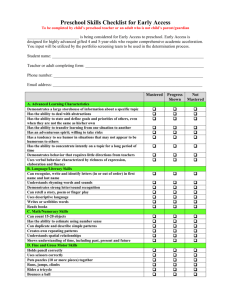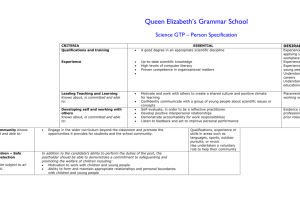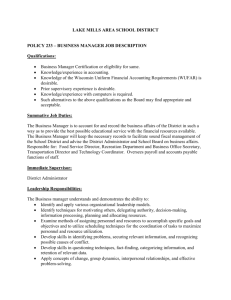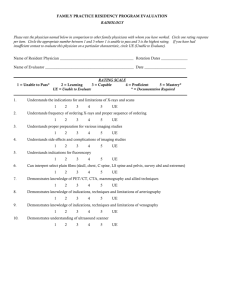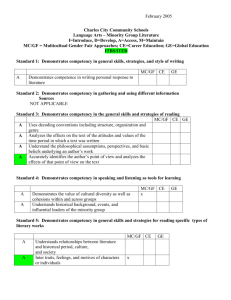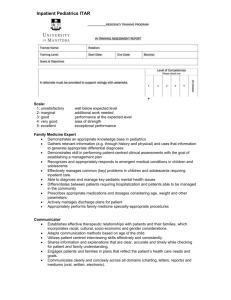Functional Curriculum Guide
advertisement
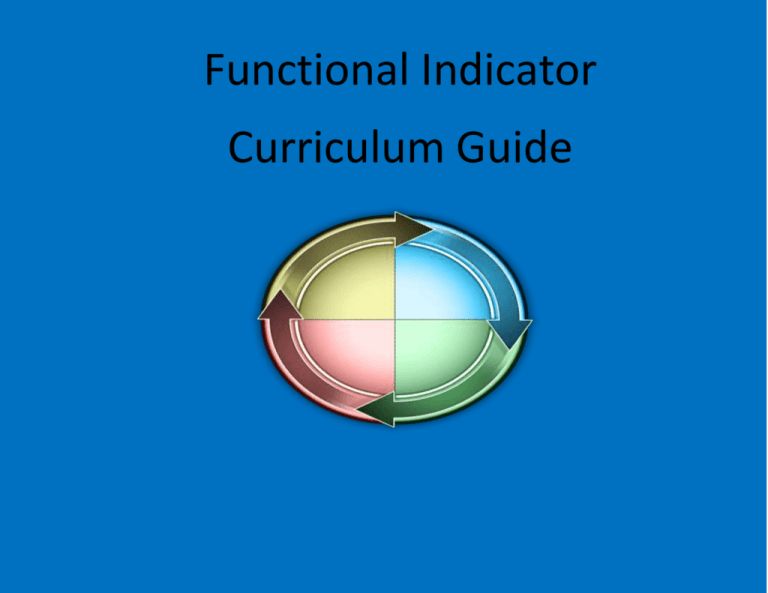
Functional Indicator Curriculum Guide ACKNOWLEDGEMENTS Thank you to all of the “lifeskills” teachers for their suggestions, hard work , time and dedication for the past 2 years in updating the “Functional Indicator Curriculum Guide”, formerly titled “Functional Curriculum”. A special dedication to Denise Scott, former “lifeskills” teachers, who was instrumental in the updating of the “Functional Indicator Curiculum Guide”. She was an inspiration to all of us. She like so many of our “lifeskills” teachers had great insight on how to get all to succeed and kept us focused on the task of updating this resource. Unfortunately Denise is unable to see the finished product as she lost her battle with cancer in February 2008 and is no longer with us. But her drive to engage students in learning and life stays with us through this “Functional Indicator Curriculum Guide”. Using the Functional Indicator Curriculum Guide Domains, outcomes and indicators are tailored toward the individual needs of students. This document provides a range of indicators describing what students know and are able to do based on their unique needs. 2 TABLE OF CONTENTS DOMAIN A…….………………………………………………………………………………………………. 5 Pre-reading DOMAIN B……………………………………………………………………………………………………..7 Math and money handling DOMAIN C……………………………………………………………………………………………………..9 Time management DOMAIN D…………………………………………………………………………………………………….10 Domestic/home living DOMAIN E…………………………………………………………………………………………………….12 General community DOMAIN F…………………………………………………………………………………………………….14 Vocational DOMAIN G…………………………………………………………………………………………………….16 Social skills DOMAIN H…………………………………………………………………………………………………….17 Communication skills DOMAIN I……………………………………………………………………………………………………...18 Motor skills 3 Mission Statement To build on student’s with moderate to severe disabilities abilities and to develop life skills in preparation for becoming contributing members of the community. Belief Statements 1. That students with moderate to severe disabilities may require adapted general education curriculum with a lifeskill focus and a departure from the traditional general education in order to be more directly prepared for the demands of adult life. 2. That the curriculum framework is not intended to separate students with moderate to severe disabilities from their peers without disabilities. 3. That the instructional domains contained in this framework overlap with curriculum offered to students in general education. 4. That efforts should be made to explore educational opportunities where all students are able to learn together. 5. That this is a framework for decision making that should be used as a guide to plan for each individual student. 6. That students with moderate to severe disabilities learn best when family, school, and community form a partnership to work as a collaborative team to meet the individual needs of each student. 4 NOT HIERARCHICAL DOMAIN A – READING PRE-READING OUTCOME: Students can demonstrate the skills necessary for functional reading. Self select materials for a variety of reasons Points to pictures Seeks information about pictures Follows verbal directions to find a picture. Looks at book right side up Follows a picture schedule Understands concepts of print (top-bottom, leftright) Correctly responds or answers “yes”, “no” questions Listens to a story read by peer or adult Demonstrates voice-toprint match (1 spoken word for each written word) Begins to match picture to word Recites letters of the alphabet Recognizes words by applying sound or picture symbols Recognizes upper and lower case letters BEGINNING READING Names and recognizes letters and their sounds Reads food words Names upper and lower case letters Attempts to sound out words Reads or identifies letters to names Makes sounds for beginning /ending blends Reads color words Matches picture to words Finds key words in story Alphabetizes words to the first letter Alphabetizes words to the 2nd, 3rd, 4th letter Reads letters in first and last name Can state or give personal information to familiar person or stranger when appropriate as in needing help Reads personal information Identifies beginning/ending sounds Recognizes signs seen in the community Reads several high frequency sight words including: warning signs labels, survival words, etc. Links cause and effect PERSONAL INFORMATION Identifies first and last name Traces, copies, writes or types name/personal information 5 COMPREHENSION Retells story using picture cues Demonstrates meaning of synonyms NOT HIERARCHICAL Predicts story events Sequence main story event Draws conclusions Sequences with beginning, middle and end Highlights key information Demonstrates meaning of opposites Able to answer questions regarding content of what was read Reproduces geometric shapes with or without model Prints name of parent/guardian Can imitate a vertical, horizontal line Can imitate a circular stroke Can imitate any stroke Writes personal information Copies simple words in manuscript Fills out daily/weekly assignment sheet Types lower case words and sentences Writes high frequency words Uses correct letter size and spacing of letters Writes from imagination or interest Uses correct spacing between words types personal information Uses proper indention for paragraphs Writes abbreviations Handles computer and CD, flash drive correctly Addresses, stamps and mails letters Writes contractions Copies sentences correctly Writes sentences from dictation Writes a letter Writes paragraph of 3-5 sentences on topic Access using a touch screen Edits writing for punctuation and grammar Fills out and/or completes simple graphic organizer Reads abbreviations Describe or draw elements in a story WRITING Colors with up, down, side-side motion Reproduces upper and/or lower case manuscript letters with or without model Marks notes/events on calendar Writes answers to simple questions Operates a simple keyboarding program Writes from personal experience Fills out a variety of forms/slips/checks Writes basic highfrequency writing words Prints simple messages Uses spell checker 6 DOMAIN B – MATH - NUMBERS AND MONEY HANDLING NOT HIERARCHICAL COUNTING Outcome: Students can demonstrate skills necessary for using numbers functionally. Rote counts numbers 1100 Identifies numbers 1-100 Demonstrates and understanding of 1:1 correspondence Sequences numbers 1-100 Matches numbers 0-100 or more with sets of objects Counts and writes numbers by 2’s, 5’s, 10’s and 25’s to 100 Places and counts ordinal position through tenth Understand spatial concepts over, under, etc. Understands vocabulary of more, less, half, whole, etc. Adds/subtracts 1 digit numbers with no regrouping Multiplies/divides 2 or more digits with regrouping Adds/subtracts 2 digit numbers with no regrouping Matches number card to number on calculator Adds/subtracts 2 or more digits with regrouping Recognizes and continues a pattern LANGUAGE OF MATH Recognizes and understands symbols of math (+, -, =, <, >, $, ¢) COMPUTATION Knows addition/subtraction facts 0-9 from memory Multiplies/divides 2 or more digits with no regrouping Know multiplication/division facts 0-9 from memory Uses a calculator for computation 7 MONEY Names coins/bills Demonstrates coin equivalence, penny=1¢, nickel=5¢, dime=10¢, quarter=25¢ Estimates amount of purchase NOT HIERARCHICAL Indentifies values of coins/bills Totals money amounts with calculator Counts like coins Count mixed coins Counts mixed coins/bills Totals money amounts without calculator Determines change with calculator Determines change without calculator Keeps track of amount of money in personal account Writes check and/or money orders Keeps record of monthly spending Opens checking and/or savings account Knows how to use & maintain a debit &/or credit card Budgets for a meal Demonstrates knowledge of measuring cups, ¼, ½, ¾ , and 1 cup Can match actual measuring cup to specified measuring cup in recipe Demonstrates knowledge pint, quart,1/2 gallon, gallon Selects correct bill for purchase (round up) PERSONAL FINANCE Makes simple budget with monthly income/expense Keeps money in a safe location Maintains a check register Makes deposits/withdrawals Understands the cycle of earning and spending Prepare and maintain a personal budget for a specific period of time MEASUREMENT Locates 1 inch, ½ inch, ¼ inch, etc. on a ruler Reads a thermometer Demonstrates knowledge of measuring spoons, ¼, ½, ¾ , and 1 teaspoon/tablespoon Uses a scale or balance Measures ingredients in a simple recipe 8 DOMAIN C – TIME MANAGEMENT NOT HIERARCHICAL CLOCK SKILLS Read numbers on clock Sets clock and alarm Tells time to hour, ½ hour, 5 min, 1 min. intervals on analog clock/watch Prepare and maintain a personal budget for a specific period of time Utilizes clock schedule to go to class, lunch, PE, etc. Uses clock to determine elapsed time Uses a clock to budget time Independently manages time to start a new activity Estimation of time, “about a week ago”, “at about 7 o’clock”, etc. Follows directions using time (5 minutes to clean up and then in your seats) Understands morning, afternoon, evening A.M./P.M. Follows daily written or icon schedule States what current day is, yesterday was and tomorrow will be Reads and/or writes days of week in random order Locates past and future dates on calendar Identifies special calendar days/holidays/events Scheduling Tells seasonal weather and Tells months of year in months order States, spells and writes days of week in random order States, spells and writes day, month, year ANTICIPATES UPCOMING EVENTS/ACTIVITIES Independently manages calendar/planner and handles changes in schedule Uses calendar/planner for schedule, appointments, events 9 DOMAIN D – DOMESTIC/HOME LIVING NOT HIERARCHICAL OUTCOME – Students can demonstrate the skills necessary for food preparation and post meal clean up. Makes food choices (favorite, healthy, food groups) Uses knife to spread Opens condiments & containers (milk carton, jar lids, etc) Hold & use fork, spoon & knife appropriately Pours from container to cup/glass Uses sanitary work habits, washing of hands, not coughing over foods, etc. Uses microwave, mixer, blender, toaster, stove kitchen timer Knows safety rules for kitchen appliances Makes shopping list Sets table Demonstrates knowledge of appropriate portions when eating a meal Eats neatly in own personal space Knows cooking terms/abbreviations Plans a meal menu Is able to measure using cups and spoons Scrapes food from dishes into garbage Sweeps floor and uses dust pan for pick up Puts dishes and soap into dishwasher Turns on dishwasher Mops floor Returns meal items to storage locations Understands hot/cold temperatures Washes and dries dishes Puts dishes away Uses garbage disposal Wraps and stores food using Tupperware containers, twist ties, Ziploc bags, etc Wipes table, chairs, counter tops Demonstrate knowledge of using hot pads, oven mitts, etc. Follow simple recipe Can divide/cut food portions/cake into pieces for serving others 10 DOMAIN D – DOMESTIC/HOME LIVING (con’t) NOT HIERARCHICAL OUTCOME – Outcome: Students demonstrate the skills necessary for grooming and dressing. Bathes/showers/washes hair as needed Brush teeth Cares for hair Shaves or allows shaving as necessary Put on/off shirt, coat Pull up/down pants Button/unbutton Unsnap/snap Dresses and undresses independently Tie shoes Zip/unzip and connect/disconnect article of clothing Fastens velcro (shoes, etc.) Identifies seasonal clothing Keeps eye glasses clean Uses deodorant daily Matches clothes Wears clean clothing Blows nose when necessary Purchases own wardrobe item from store Knows clothing size Indicates need to use the toilet Reads restroom signs for Men/Women Uses toilet paper. Uses restroom independently Washes face/hands with soap and water or hand sanitizer Cares for feminine hygiene independently Independently washes/dries clothes Dresses appropriately for weather 11 DOMAIN E – GENERAL COMMUNITY NOT HIERARCHICAL Outcome: Students can demonstrate the skills necessary to function as a community consumer. Uses phone, texting, email Identifies where clothing (shoes, shirt, etc.) can be purchased Demonstrates appropriate Makes simple purchase at behavior in the community store or restaurant Identifies where food can be purchased Identifies eating establishments Is able to make menu choices Uses school or public library Uses Laundromat Uses Post Office Uses grocery store list with words/pictures Uses department store maps/guides Ride up/down escalator Operate elevator (locate correct level) Uses vending machine Uses restaurant menu Has a plan in case they get lost Knows where departments are within store Asks for assistance when necessary Compares prices and gathers coupons Makes list of needed items Manages money for purchase Goes through check out Is able to get change for bills when necessary Is able to determine if correct change is given Knows how to exchange/return item Carries medical insurance card Knows how to fill out medical forms Cancels appointments when necessary Knows how to use Yellow Pages/internet for reference Knows debit/credit card responsibilities Follows directions given over the phone/email Uses shopping basket/cart Knows basics of carrying and using ID card 12 DOMAIN E – GENERAL COMMUNITY (con’t) NOT HIERARCHICAL Outcome: Students can demonstrate the skills necessary for community access Stays on sidewalks Basic use of crosswalk Knows and understands traffic signals Demonstrates appropriate behavior while in vehicle or community settings Understands strangerdanger Accesses internet for appropriate information Follows schedule, arrival/departure Understands role of community helpers, doctors, police officers, mailman, etc. Understands how to get community access contacts (Parks & Recs., etc.) Recognizes "Handicap” Accessible" facilities Demonstrates knowledge of use of safety and safety signs within the community Navigates/transitions independently within community Knows map skills (North, South, East, West), read a road/street map Navigates/transitions independently within school community Knows how to access community transportation Knows rights for handicapped Demonstrates understanding of how to follow steps to Achieve community transportation, cab, “JO”, etc. Outcome: Students can demonstrate the skills necessary for recreation/leisure Participates in group Chooses a peer to games/activities/parties/school play/socialize with dances etc. Uses playground equipment Engages in appropriate leisure activity independently Chooses activity to play with friend Transitions from room, etc. to activity displaying appropriate behavior Knows basic independent and/group active social activities Is able to find and use community resources for Fun & Leisure Knows basic independent and/group passive social activities Can choose an item/activity to do alone 13 NOT HIERARCHICAL DOMAIN F- VOCATIONAL Outcome: Students can demonstrate skills necessary for employment Locates classified adds in looking for employment and “help wanted” notices If needs social security card information knows how to find Uses internet to search / apply for jobs Writes simple resume Names parent place of employment Carries social security card & knows social security number Demonstrates interview skills Writes follow-up letter/thank you card after interview Writes own name or uses name stamp Reports to & begins work promptly Expresses realistic goals related to job/careers Understands each job has different requirements Identifies qualifications for a specific job Uses break times appropriately Writes personal information Maintains regular attendance at work site Exhibits self motivation as it pertains to employment Demonstrates initiative as it pertains to employment Attends to and completes assigned task Follow rules on worksite Accepts help from adult & peers at the worksite Notifies employer ASAP when going to be ill or late Cooperates with employer Exhibits social courtesies as it pertains to employment Functions in a group setting Gathers necessary materials for work Keeps personal items in appropriate place Retrieve and stores work materials Obtains change for a machine Sequences daily activities Addresses envelopes Reads labels as it pertains to employment Matches and sorts by size, color, shape Alphabetizes by first letter, alphabetizes by first two letters Packages materials Completes simple forms as it pertains to employment (application, timesheet, ext.) Works independently Follows daily employment routine independently Writes a letter using correct form as it pertains to employment Asks for and follow directions to a location Brings all necessary materials to work Maintains "on-time" behavior for arrival, departure, break times Follows verbal directions Staples with assistance Collates with assistance Places adhesive labels in position with help Displays appropriate behavior on worksite Stuff envelopes with assistance Uses tools Maintains consistent rate of production Works independently Explores occupations of personal interest Follows daily employment routine independently Maintain a clean work area Takes care of work materials and equipment 14 DOMAIN F- VOCATIONAL (con’t) NOT HIERARCHICAL Tolerates visual/auditory stimuli in employment setting Respects property of others as it pertains to employment Uses measurements Is able to do assembly line work Exhibits occupational safety Follows simple pictorial directions Recognizes written/verbal name as it pertains to employment (time card, paycheck, etc) Uses time clock/card Does not disturb others during work Works without continuous reinforcement Tolerates working close to others (proximity) Tolerates working consistently for 30/more minutes on a work task Corrects unsatisfactory work willingly Seeks help if unable to problem solve on the job Respects company materials and equipment Follows an established pattern (setting table, staple items, etc) Knows how to handle special equipment Handles change in routine/procedure Shows interest in trying a new task Knows procedure for terminating a job Maintains work quality expectations Using a variety of methods such as job shadowing, community job placement, CREWS, etc. to explore career options. Works designated period without breaks Handles job emergencies Indicates when job is finished Handles new duties and responsibilities Communicates job responsibilities Evaluates own job performance Correctly completes 1-5 step work tasks Tolerates interruptions Is able to problem solve on the job Cooperates with fellow employees Appropriately transitions from one work task to another without difficulty Manages stress appropriately Dresses appropriately for the job Demonstrates understanding of how to follow steps to achieve transportation to get to and from work 15 NOT HIERARCHICAL DOMAIN G – SOCIAL SKILLS Outcome: Students will demonstrate the skills necessary for family and social interaction Follows verbal/written directions Joins group of close friends during lunch Helps peer with a project Displays appropriate greetings Does simple tasks without instruction Compliments friends and family Greets friends for specific purpose Manages own behavior without help Gives feedback and reinforcement to others Invites friend over for social time Smiles when adults says name Turns down offer for assistance Shares objects & activities with peers Knows when to use specific behaviors Ignores inappropriate behavior Looks at speaker Follows situational cues of others Gets clarification when necessary Makes appropriate choices Obtains & responds to relevant situational cues Stops behavior when told Gain attention from others appropriately Display appropriate behavior in public/home Uses appropriate voice level Helps someone when help is needed Follows/responds appropriately to directions given by teachers, para, supervisor, etc. Understands consequences Understands the physical space of others Refrains from interrupting others Respects the property of others Exhibits good self esteem Accepts being corrected Share materials Sits in group appropriately Able to take turns in conversation Is able to problem solve Participates in group activities Able to make introductions Tolerates non-preferred activity Understands personal space/boundaries Provides information Shares a task with peer Resolves conflicts without physical contact or abrasive language (stating emotions/desire or walking away) Demonstrates social courtesies/manners Maintains peer/adult relationships Recognizes & responds to emotion in self and others Demonstrates positive attitude Organizes own activities for the day Sets realistic goals for self Tells adult of accident or problem Participates in discussions/conversation Understands situations where it is o.k. to say "No" Responds appropriately to teasing Knows where to seek advice Appropriate usage of cell phone 16 DOMAIN H – COMMUNICATION SKILLS NOT HIERARCHICAL Outcome: Students will demonstrate the skills necessary for functional communication. Attends to simple requests Request/gain attention and assistance Responds to own name Makes eye contact/ eye gazes Gives attention to speaker Gestures yes/no Responds to facial expressions Uses appropriate expression for situation Uses augmentative device Orally uses 3 word phrases Writes 3 word phrases Associates pictures with wants and needs Answers question after verbal information given Asks “wh” questions Makes local calls to make request / give information Articulates/communicates fluently Initiates social courtesies / responds to social courtesies Uses appropriate voice on telephone Responds to own name Provides information about person, event, object Takes turn in conversation Uses plurals/pronouns/past tense/future tense Responds to names of others Responds to ‘Who’s that?’ Demonstrates letter writing Verbalizes own feelings to others Relays messages or information Responds to yes/no Responds to ‘Show me___’ Responds to ‘Point to___’ Responds to ‘What’s that?’ Responds to ‘When?’ Responds to ‘Where?’ Gives a response to ‘Why?’ Follows simple verbal directions / written directions Gives a response to ‘Why?’ Gives a response to “How?” Follows simple verbal directions / written directions Follows multi-step verbal directions / written directions Demonstrates active participation in conversations (reciprocates conversations) 17 DOMAIN I – MOTOR SKILLS NOT HIERARCHICAL Outcome: Student will demonstrate functional motor skills. Purposeful reaching Picks up, holds, uses pencil or marker easily Cuts with scissors on straight line and/or circle Grasps with thumb and one finger Uses two fingers to obtain small object Cuts food into bite-sized portions Places object rather than drops Uses two hands to obtain large object Uses appropriate pace in movement throughout their environment Ties / slips on / velcros shoes Imitates vertical and/or horizontal marker strokes Uses Computer keyboard accurately Cuts with scissors Copies cross, square, triangle Manipulates phone keypad accurately 18
